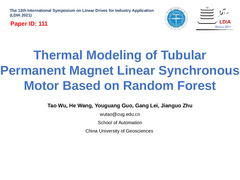Copyright © The 13th International Symposium on Linear Drives for Industry Application
Powered by
Aconf.org
, One-stop Solutions for Academic Events

Start Time:2021-07-02 10:30 (Asia/Shanghai)
Duration:20min
Session:[S1] Concurrent Session 1 » [S1-3] Oral Session 11 & 14
Tips: The file permissions under this presentation are only for participants. You have not logged in yet and cannot view it temporarily.
Tao Wu (M’19) received the B.E. degree and the M.S. degree from the China University of Geoscience, Hubei, China, in 2001 and 2004, respectively; and the Ph.D. degree in motors and electrical appliances from the Huazhong University of Science and Technology, Wuhan, China, in 2010.
He is currently an associate professor with the School of Automation, China University of Geoscience. His current research interests include motors and controls, design and optimization of electrical systems, and equipment and instruments.
Comment submit